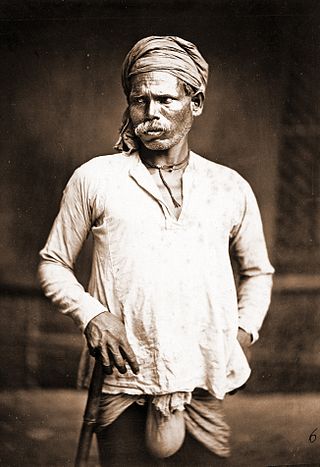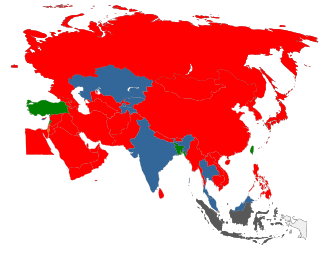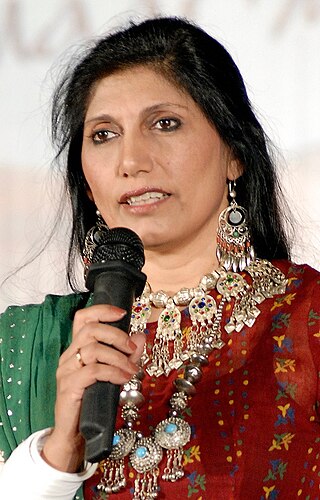
Nomads are communities without fixed habitation who regularly move to and from areas. Such groups include hunter-gatherers, pastoral nomads, tinkers and trader nomads. In the twentieth century, the population of nomadic pastoral tribes slowly decreased, reaching an estimated 30–40 million nomads in the world as of 1995.

Meena is a tribe from northern and western India which is sometimes considered a sub-group of the Bhil community. It used to be claimed they speak Mina language, a spurious language. Its name is also transliterated as Meenanda or Mina. They got the status of Scheduled Tribe by the Government of India in 1954.

The Dom, also known as Domra, Domba, Domaka, Dombara and Dombari, are castes, or groups, scattered across India. Dom were a caste of drummer. According to Tantra scriptures, the Dom were engaged in the occupations of singing and playing music. Historically, they were considered an untouchable caste called the Dalits and their traditional occupation was the disposal and cremation of dead bodies. They are in the list of Scheduled caste for Reservation in India in the Indian states of Uttar Pradesh, Bihar, Odisha, Andhra Pradesh, Jharkhand and West Bengal.

Bol (transl. Speak) is a 2011 Pakistani Urdu-language social drama film written, directed, and produced by Shoaib Mansoor. The film stars Humaima Malik, Atif Aslam, Mahira Khan, Iman Ali, Shafqat Cheema, Amr Kashmiri, Manzar Sehbai, and Zaib Rehman in the lead roles. The film marks the debut of singer Atif Aslam and actress Mahira Khan. It concerns a family facing financial difficulties caused by too many children and changing times, with a major plot involving the father's desire to have a son and his rejection of his existing intersex child. Bol was a critical and commercial success and became one of the highest-grossing Pakistani films of all time.
Heera Mandi, is a neighbourhood and bazaar located in the Walled City of Lahore. It is specifically known as the red light district of Lahore, Pakistan.

Hakim Syed Zillur Rahman is an Indian scholar of Unani medicine. He founded Ibn Sina Academy of Medieval Medicine and Sciences in 2000. He had earlier served as Professor and chairman, Department of Ilmul Advia at the Ajmal Khan Tibbiya College, Aligarh Muslim University, Aligarh, for over 40 years before retiring as Dean Faculty of Unani Medicine. Presently, he is serving AMU as "Honorary Treasurer". In 2006, the Government of India awarded him the Padma Shri for his contribution to Unani Medicine.

Nomads are known as a group of communities who travel from place to place for their livelihood. Some are salt traders, fortune-tellers, conjurers, ayurvedic healers, jugglers, acrobats, actors, storytellers, snake charmers, animal doctors, tattooists, grindstone makers, or basketmakers. Some anthropologists have identified about 8 nomadic groups in India, numbering perhaps 1 million people—around 0.12 percent of the country's billion-plus population. Aparna Rao and Michael Casimir estimated that nomads make up around 7% of the population of India.
Nawar is an Arabic term for several nomad communities used primarily in Jordan, Syria, Lebanon, and Palestine. The term, regarded as derogatory, is used by Arabs for several diverse ethnic groups. They have historically been called "Gypsies", though as a whole they are not Romani per se. The Dom people are especially known as Nawar. While both they and Romani people originated from India, they came from two drastically different ethnicities and cultures.

Prostitution in Pakistan is a taboo culture of sex-trade that exists as an open secret but illegal. Prostitution is largely based in organisational setups like brothels or furthered by individual call girls.
The Ghorbati are an ethnic group and originally a nomadic community in Iran Afghanistan, and Central Asia, where they are part of the various communities termed Lyuli. They are mostly situated in Iran, where others have migrated from. They trace their ancestry to Sassanid Persia.

Fouzia Saeed is a Pakistani social activist, gender expert, trainer/facilitator, development manager, folk culture promoter, television commentator, and author.
The Mirasi are a community found in North India and Pakistan. They are folklore tellers and traditional singers and dancers of a number of communities. The word "mirasi" is derived from the Arabic word (ميراث) mīrās, which means inheritance or sometimes heritage. In the strict grammatical sense of the term, they are considered to be propagators of the cultural and social heritage. Haris lali is the successor of mirasi family
There are several ethnic groups in Afghanistan which traditionally lead a peripatetic life. This means they are nomadic and their main occupations centre around providing services to the settled populations they travel among, like peddling particular goods or performing music. In this way, they contrast both with the settled population and with the pastoralist nomads. They are of low social status and are known to outsiders as Jats, a derogatory term that none of the groups use as a self-designation.
The Qalandar are a Muslim ethnic group found in North India and Pakistan. They are also known as Qalander Faqir. A few Qalandar are also found in the Terai region of Nepal.
The Gandhila sometimes pronounced as Gandhil and Gandola, are a Hindu caste found in North India. They have scheduled caste status in Punjab and Haryana.
Ādurgari is a secret language of the nomadic Shaikh Mohammadi group of peddlers of east Afghanistan, used especially in the presence of outsiders. It is taught to children starting at the age of six or seven as they would be speaking Persian until then; all adults speak it in addition to their native Dari. The name is apparently derived from a word referring to their activity of peddling (ādur), and it has tentatively been suggested this might indicate a possible connection with the Harduri people of Uzbekistan.

Changar or Chingar are an ancient mysterious vagabond tribe of South Asia.
The Domari-speaking community in Syria, commonly identified as Dom and Nawar, is estimated to number 100–250,000 or 250–300,000 people. The vast majority is sedentary. There are semi-nomadic groups, some moving outside the country. In Aleppo, the Dom community is probably the largest, while they are reported to live in Damascus, Homs and Latakia as well. The community is highly marginalised in society, and they are referred to as Qurbāṭ and Qarač in the northern part, and Nawar elsewhere. These terms are used for various groups that mainly share socio-economic profile. The community is divided into clans.

Aparna Rao was a German anthropologist who performed studies on social groups in Afghanistan, France, and some regions of India. Her doctorate studies focused on anthropogeography, ethnology, and Islamic studies. Rao taught anthropology at the University of Cologne, serving for a brief time as chair of the Department of Ethnology at the South Asia Institute of Heidelberg University, Germany.









